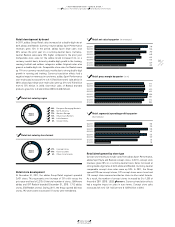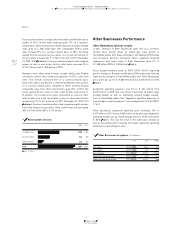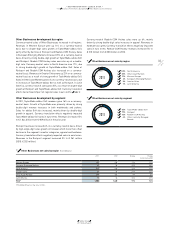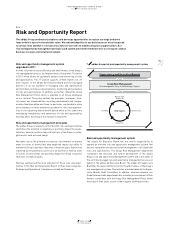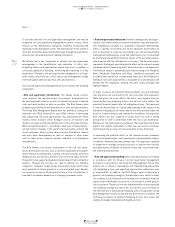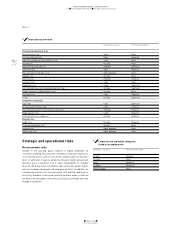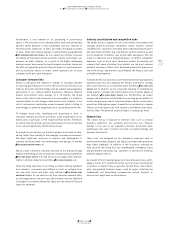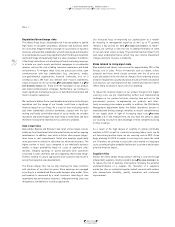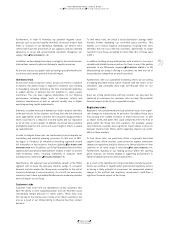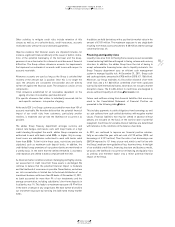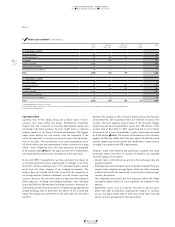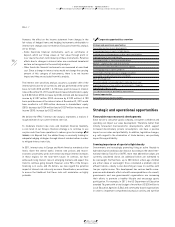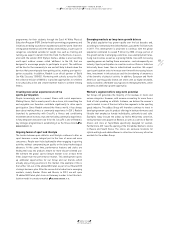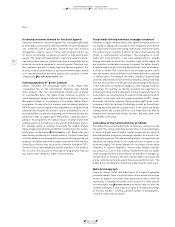Reebok 2011 Annual Report Download - page 155
Download and view the complete annual report
Please find page 155 of the 2011 Reebok annual report below. You can navigate through the pages in the report by either clicking on the pages listed below, or by using the keyword search tool below to find specific information within the annual report.
adidas Group
2011 Annual Report
GROUP MANAGEMENT REPORT – FINANCIAL REVIEW
151
2011
03.4 Risk and Opportunity Report Strategic and operational risks
Furthermore, in order to minimise any potential negative conse-
quences such as product quality shortfalls, increased product lead
times or violation of our Workplace Standards, we enforce strict
control and inspection procedures at our suppliers and also demand
adherence to social and environmental standards throughout our
supply chain
SEE SUSTAINABILITY, P. 107
.
In addition, we have bought insurance coverage for the risk of business
interruptions caused by physical damage to supplier premises.
As a result, we assess supplier risks as having a possible likelihood of
occurrence and a major potential financial impact.
Inventory risks
As we place initial production orders around six months in advance
of delivery, the adidas Group is exposed to inventory risks relating
to misjudging consumer demand at the time of production planning.
A sudden decline in demand has the potential to cause excess
inventories. This can have negative implications for our financial
perform ance, including higher levels of clearance activity and
inventory obsolescence as well as reduced liquidity due to higher
operating working capital requirements.
Similarly, a sudden increase in demand can lead to product shortfalls
at the point of sale. In this situation, our Group faces the risk of missed
sales opportunities and/or customer and consumer disappointment,
which could lead to a reduction in brand loyalty and our reputation
as an on-time, in-full supplier. In addition, the Group faces potential
profitability impacts from costs such as air freight in efforts to speed
up replenishment.
In order to mitigate these risks, we continuously strive to improve our
forecasting and material planning processes. To that end, in 2011,
we began to introduce an enhanced forecasting approach around
full integration of key business functions globally
SEE INTERNAL GROUP
MANAGEMENT SYSTEM, P. 114
. In addition, our Global Operations function offers
sophisticated and tailored replenishment models in order to shorten
order-to-delivery times, ensuring availability of products while
avoiding excess inventories
SEE GLOBAL OPERATIONS, P. 90
.
Nevertheless, the expected over-proportionate growth of the Retail
segment will increase the exposure towards swings in consumer
demand, and also makes the Group more susceptible to the risk of
inventory shrinkage or excess inventory. As a result, we now assess
inventory risks to have a probable likelihood and a moderate potential
financial impact on our Group.
Customer risks
Customer risks arise from our dependence on key customers who
have the ability to exert bargaining power and can therefore cause
considerable margin pressure or cancel orders. These risks exist
not only due to the relative size of some of our major customers, but
also as a result of our limited ability to influence how they conduct
business.
To limit these risks, we utilise a broad distribution strategy which
includes further expanding our controlled space activities. This
enables us to reduce negative consequences resulting from sales
shortfalls that can occur with key customers. Specifically, no single
customer of our Group accounted for more than 10% of Group sales
in 2011.
In addition, building strong relationships with retailers to become a
valuable and reliable business partner for them is one of the guiding
principles of our Wholesale segment
SEE WHOLESALE STRATEGY, P. 63
. By
differentiating our product offering to customers, we limit the risk of
increased price competition on specific products.
Furthermore, with our substantial marketing efforts we are aiming
at building desirable brands which resonate with the tastes of our
consumers and ultimately drive high sell-through rates for our
customers.
Given our strong partnerships with key retailers, we now view the
likelihood of occurrence for customer risks as likely. The potential
financial impact on the Group is regarded as major.
Regulatory risks
Regulatory risks predominantly include potential losses from signifi-
cant changes to trade policies. In particular, the adidas Group faces
risks arising from sudden increases of import restrictions, as well
as import tariffs and duties that could compromise the free flow of
goods within the Group and from suppliers. For example, several
Latin American countries have significant import duties in place on
footwear imports from China, which negatively impacts our profit-
ability in these markets.
To limit these risks, we proactively utilise a regionally diversified
supplier base, which provides some protection against unforeseen
changes in regulations and also allows us to shift production to other
countries at an early stage if necessary
SEE GLOBAL OPERATIONS, P. 90
.
Furthermore, building on our leading position within the sporting
goods industry, we actively engage in supporting policymakers to
liberalise global trade and curtail trade barriers.
As a result of the likelihood of rising protectionist activity by govern-
ments, we continue to regard further political and regulatory actions
as having a likely potential of occurrence. An unexpected material
change in the political and regulatory environment could have a
signifi cant financial impact on the Group.


